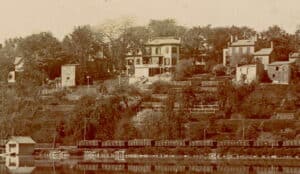Terraced Gardens
(From the September 1998 Historical Society Newsletter)
The natural terraces, which line the north end of the lake along South Main Street, have been a source of beauty for over 200 years. Charles Williamson, one of the founders of Geneva, desired to preserve this beauty for future generations. He designated the lakeside lots to be solely used for gardens for the properties on the west side of South Main Street to enhance visual beauty of Geneva. In 1829, Charles Butler built the house which is now known as the Geneva History Museum. When Bulter would reminisce about his years in Geneva he only had fond memories and at one point stated, ….where so much has been suffered and enjoyed, the houses, the people, the trees, the shrubbery and the flowers around me like familiar friends; reminding me of the past; bringing to view the good and evil of our existence, the light and shade, the joy and sorrow.[1]

The terraced gardens behind the Prouty-Chew House are visible in this image taken from Seneca Lake in 1896.
During the Victorian Era in Geneva, the interest in nature and gardens flourished. This rise in interest, can be seen in the lives of the Prouty family, which is documented in the diaries and journals of Adelaide Cobleigh Prouty. Several of her entries deal with the gardens on the grounds. The garden was used for several reasons, including walks, access to the lake, a play area for the children and as a spot for inspiration and retreat. As Adelaide states in her journal on May 17, 1857, “Instead of a sermon, Phin and I this morning went into the garden to see what progress spring had made.”
The garden was also used for the planting and harvesting of flowers and other plants. Many different species of flowers and plants were documented as composing the garden. They included daffodils, tulips, hyacinths, crocuses, pansies, phlox, primulas, alyssum, locust trees, vines, tomato plants, fuchsias, pinks, geraniums, lilacs, blue myrtle, snowdrops, grass, pink lilies, lily of the valley, and chrysanthemums. The flower which was most noted in the journals was the violet: “Went out in the garden this morning a bunch of violets so fragrant and lovely.” She continues saying, “Warm again and the terrace are blue with violets peeping up everywhere. They are such gentle flowers.” Many of the gardening methods and resources used in keeping the gardens beautiful are also documented in these journals.
To preserve the lake view, Charles Williamson wanted houses built only on the west side of South Main Street. The east side was to have terraced garden lots to the lake. But real estate faced the same pressures then as now and owners began selling off the eastern lots for buildings by 1800. The frontage across from Hobart and William Smith Colleges is the only area that still reflects Williamson’s original plan.
This article was brought to you in part by our supporters. Be our partner in telling Geneva’s stories by becoming a Historic Geneva supporter.
[1] The Life and Letters of Charles Butler, 1903

So interesting ! I wonder what the gardens were like behind 859. There is still a level with tons of Myrtle.